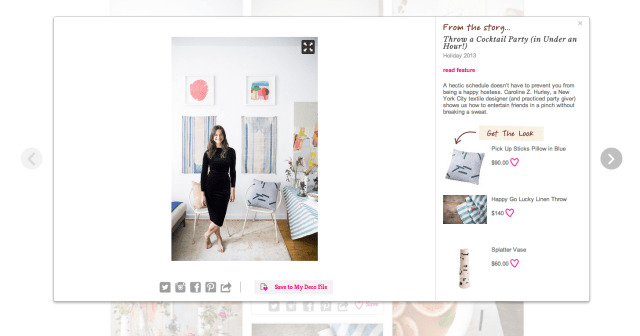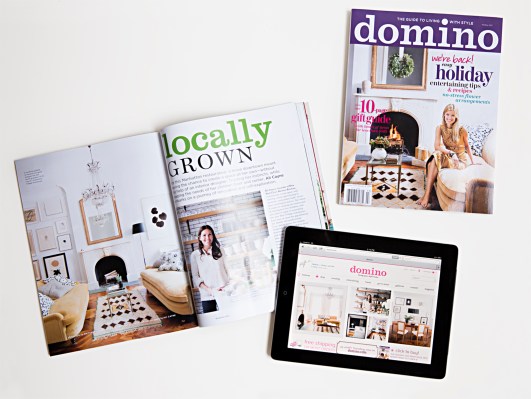For home decor junkies, 2009 was a dark year, marking the shuttering of Condé Nast’s shelter magazine, Domino, after four years in circulation. Today the magazine rises from the dead.
There are a few marked differences. It is now a startup that operates autonomously from Condé Nast. A print magazine will go on newsstands quarterly, but the team isn’t selling subscriptions. And it’s going deep into fusing content and commerce online.
Domino is now run by Project Décor, a design ecommerce startup founded in 2011 by Andy Appelbaum, a co-founder at Seamless Web, Aaron Wallace, and Cliff Sirlin. The team at Project Décor started speaking with Condé Nast, which wanted to figure out a way to utilize the dormant Domino brand, and it became apparent that this was the right team to lead the magazine’s revival.
“A startup within a large organization probably wasn’t the best strategy,” Appelbaum said. “So [we said], let’s take their assets, their brand, their expertise, their titles, their ad support, their consumer marketing database, and bolt it onto our tech infrastructure along with an editorial voice through Michelle Adams.”
Adams being the former Domino editor who went on to found the online shelter magazine Lonny after Domino’s close. She is now back to drive content at Domino 2.0, meaning the editorial point of view will be essentially the same as that which captured the hearts of the magazine’s original cult following.
Advance Publications, the parent company of Condé Nast, is a minority investor in Project Décor. The startup has also received backing from LaunchCapital and iNovia Capital, along with a number of angel investors. Maria Thomas, the former CEO of Etsy, has joined Domino as its first advisor. While Condé Nast will provide support and archival content for the new Domino, the magazine is now an independently run venture.
Part of the motivation for the re-launch is that the former, print Domino wasn’t able to reach its potential as a shopping platform.
“Domino was ahead of its time,” said Condé Nast President Bob Sauerberg. “Technology had advanced and now allows us to re-imagine the brand in a more interactive way. The brand has always been highly resonant among design enthusiasts and now, with commerce and social capabilities, it will be easy for them to achieve the look they want.”
The new Domino is a big content/commerce play. Though revenue is driven by the commerce side, the team emphasized that they are an editorial company first.
The website gives visitors a number of viewing options, each optimized to service shopping a little differently. On every article, there are buttons up top to read the story, shop it, and view its photos.
In reading mode, the article’s text and photo layout gives it a distinctly magazine-like feel. Shopping the story shows users the home goods used in the story — if it’s a piece about Coco Chanel’s Paris apartment, Domino will display products similar to the vintage ones. The “View Photos” mode switches over to a tiled format like that of Pinterest or The Selby. It shows all of the photos that didn’t make it into the body of the article, all of which are of course shoppable.
Toggling between the different viewing modes may sound like a lot, but each serves a pretty distinct purpose. Although the point of Domino is to help people shop — the former print edition was the sister publication to Lucky, the women’s shopping magazine — breaking up the story and shopping verticals means viewers aren’t constantly being whacked over the head with buy buttons. Plus, it looks pretty.

For its ecommerce, Domino has eschewed an affiliate model for its commerce in favor of operating as the retailer.
“We never wanted to be an affiliate for a multitude of reasons. The notion of being linked out and sitting on Crate & Barrel destroys the magic of the experience and the value of keeping readers on our platform. It also kills our margin,” Sirlin said.
Commerce will likely comprise 85-90% of revenue, the team said, although they’re still waiting to see how people react to it. The print magazine currently on newsstands is 132 pages long, 128 of which are Domino’s content, a crazy low ratio relative to other magazines that rely heavily on advertising.
The print magazine will come out quarterly, and the goal for the website is to put out new content daily. In addition to new content, Domino will also be releasing stories from the magazine’s archives over the next six months and making them shoppable online.
Editorial now comprises half of the 20 person team. Like any startup, that means playing multiple roles: the in-house photographer, for instance, produces all of the shots and also serves as retoucher.
As of today, Domino is live on both traditional and mobile websites, and the first edition is on newsstands. Domino will be putting out an app in the next six months, the team said.
